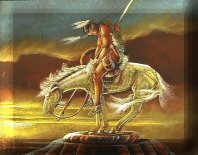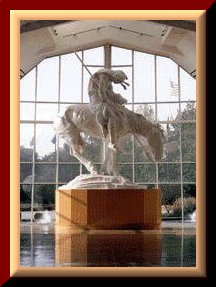|

End of the Trail
This lone figure on his weary horse is one of the most
recognized symbols of the American West.
Creator James Earle Fraser was born in Minnesota in 1876. In 1880, the family
moved to South Dakota near Mitchell. He grew up with the Sioux Indians.
Fraser's idea for his famous The End of the Trail sculpture, came about because of the many interactions Fraser had with the Indians during his
childhood days. He felt the Indians had been treated unfairly by the white
man and consequently developed a great deal of compassion for them. He remembered well how bitterly the pioneers spoke of the Indians and he could
not understand why such animosity developed.
The End of the Trail sculpture was completed in 1894 when Fraser was eighteen years old and won him the John Wanamaker Prize at the Paris
(France) American Artists Association in 1898.
Several years later, in 1915, Fraser enlarged The End of the Trail to a monumental
18-foot plaster for the Panama Pacific Exposition in San Francisco.
This version, mounted on a high pedestal, was placed in front of the Palace of Jewels, a central location within the Exposition grounds. It
was seen by tens of thousands of people at the Exposition and was reproduced on a photo postcard, a popular souvenir that helped make The End
of the Trail one of the most familiar sculptures of the American West. Fraser hoped his master piece would be cast in bronze and placed on Presidio Point overlooking San Francisco Bay, but materials restrictions during the First World War made the project impossible. Instead, the plaster work was cut up and discarded when
the exposition closed. In 1920, the city of Visalia, California, obtained the discarded pieces and
reassembled the statue in Mooney Park, where it remained, gradually deteriorating, for the following 48 years.

In 1968, the National Cowboy Hall of Fame acquired this original plaster statue and placed it as the centerpiece in the Fraser Memorial Studio building on the Museum
grounds. Following restoration, molds were made and a full-scale bronze sculpture was cast in Italy and unveiled in Visalia in 1971.


|